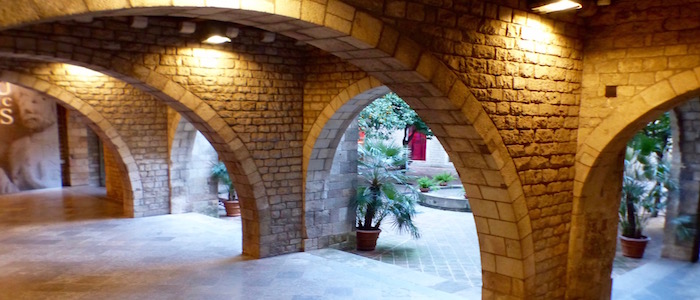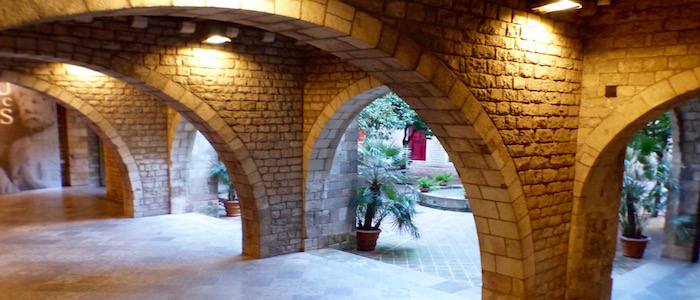

Point of interest (3) Carrer dels Comtes.
In the year 713, the city was invaded by Muslims and in 801 it was reconquered by the son of Charlemagne, who established the county of Barcelona. It was the beginning of the dynasty with an appointed count Guifré el Pilós in 873. In 988 count Borrell the 2nd declared the county independent, and this is how the true medieval identity of Barcelona began. Its heritage is the royal palace, churches and artisans’ street-names.
Let us listen to how life was with the legends that have been preserved from that time.
Legend of the suckling pigs of Barcelona. Male voice Barcelona.
As we can see, the Gothic Quarter was ruled by counts in the Middle Ages. On one occasion, the count undertook a long journey and left his wife in charge of governing the city. One day, a poor woman came to the palace to ask for alms. The countess, who was not known for her generosity, realised that the poor lady was pregnant and got rid of her by cursing at her, telling her that she could not bring children into the world if she could not support them.
The poor woman felt offended by her words and cursed her, wishing that when she became a mother, since she was also pregnant, she would be the mother of a litter of piglets, and indeed the countess had seven piglets. Horrified at what had happened, she had them put in a basket and ordered a servant to throw them into the sea. The servant had compassion and took them to his wife, so she would look after them and raise them.
After several months, the count came back, asking if he was the father of a boy or a girl. The countess told him that everything had gone wrong and that the pregnancy hadn’t ended well. Meanwhile, the servant’s wife took care of the seven piglets, which grew up and became humans. They were all so alike that they were almost indistinguishable from each other. The caretaker made them dress identically, in such a way that by appearance and dress they all looked the same.
One day, when the count went out hunting, he passed the house of his servant’s wife, and saw that the seven children were identical. He was so amused that he sat them down and talked to them. The servant’s wife said to him: “Well, you can see and enjoy them, they are your children”. The woman’s words shocked the count, who made her talk about them, and she told him what happened with the birth of his children.
The count took them to the palace and raised them as princes, and when they grew up they became great knights, they all married and had children, and they expanded the family in the city of Barcelona with knights and nobles. Everywhere they went, they were named piglets, and hence it is considered that of all the nobility of Barcelona, the Piglets are the most honourable and with most established roots in Barcelona, and although their title is not the most accurate, they hold it with honour and have a distinctive heraldic piglet on their shield.
Moral: Do not let appearances deceive you; behind a banal name can hide a great person. In the mid-12th century, Count Ramon Berenguer IV married Peronela, queen of Aragon, thus beginning a history of kings. These walls hide their palaces; together, let’s discover their stories.
Category: Barcelona walking Tags:
Contact and Booking
Mobile: +34649970408 pere.sauret10@gmail.com
Experiences
Hiking Walking Rock-climbing
Donate
Copyright © 2025 · All Rights Reserved · BarcelonaWalking Barcelona Hiking Barcelona Montserrat Costa Brava Pyrenees
Adventure Theme by Organic Themes · WordPress Hosting · RSS Feed · Log in
 BarcelonaWalking Barcelona Hiking Barcelona Montserrat Costa Brava Pyrenees
BarcelonaWalking Barcelona Hiking Barcelona Montserrat Costa Brava Pyrenees